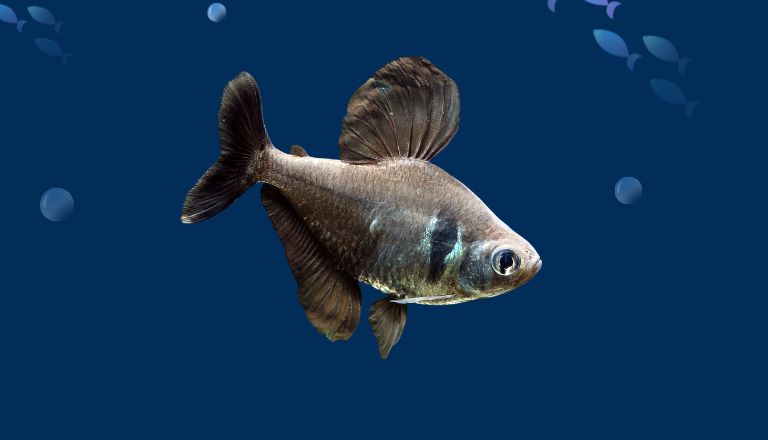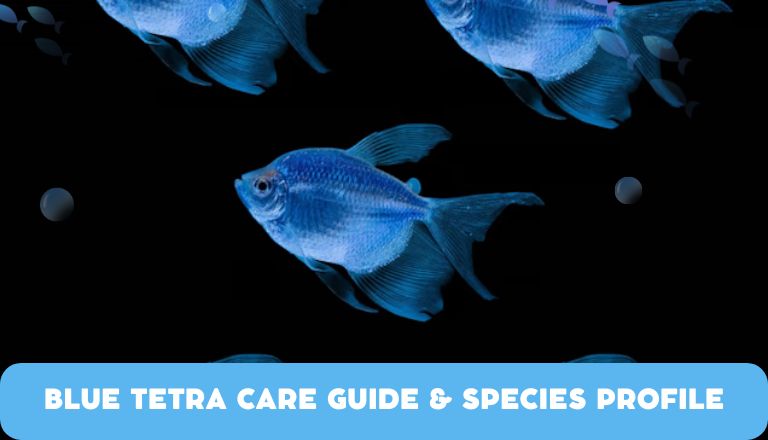Black Phantom Tetra Care Guide & Species Profile
If you’re looking to add a splash of elegance and intrigue to your aquarium, the Black Phantom Tetra is the perfect choice for you. With its striking dark hues and graceful movements, this little fish can brighten up any tank. Originating from the rivers of South America, these fascinating creatures are more than just beautiful; they are easy to care for.
In this article, I will explain everything you need to know about keeping Black Phantom Tetras healthy and happy. We’ll explore their ideal habitat, dietary needs, and social behaviors.
Black Phantom Tetra Facts & Overview
The Black Phantom Tetra is scientifically known as Megalamphodus megalopterus. Their smaller size makes them suitable for smaller tanks as well as community setups.
Their social nature allows them to thrive in schools of six or more, where they exhibit playful swimming patterns. They prefer densely planted areas with dim lighting, which mimic their natural habitats in the slow-moving waters of South America.

Black Phantom Tetra Profile Summary
| Common Names | Black phantom petra, phantom tetra |
| Scientific Name | Megalamphodus megalopterus |
| Black Phantom Tetra Family | Characidae |
| Origin | Bolivia and western Brazil |
| Tank Level | Mid-dweller |
| Minimum Tank Size | 10 gallons |
| Diet | Omnivore, eats most foods |
| Breeding | Egglayer |
| Black Phantom Tetra Care | Intermediate |
| Phantom Tetra Tank Setup | Freshwater, plants |
| pH | 6.0 to 7.5 |
| Hardness | up to 18 dGH |
| Temperature | 72 to 82 F (22 to 28 C) |
| Compatibility | Compatible with other peaceful fish species |
| Phantom Tetra Temperament | Calm and peaceful |
Origin
The Black Phantom Tetra hails from the lush waters of South America, particularly in Bolivia and western Brazil. These areas are rich with diverse aquatic habitats like the Guapor River basin and the Rio Sao Francisco. It provides an ideal environment for these captivating tetras. Their natural habitats are characterized by slow-moving waters filled with dense vegetation and dark substrates.
The Black Phantom thrives among leaf litter and aquatic plants. This setting highlights their natural behavior; they form small schools to enhance security from predators.
Adult Black Phantom Tetra Size & Lifespan
The adult Black Phantom Tetra grows to a size of around 1.75 inches (approximately 4.5 cm). This makes them a relatively small fish species, ideal for community tanks where space is limited. These fish are vibrant contributors to the aquatic environment with their striking black and silver colors.
Black Phantom generally lives up to five years with care. Water quality, diet, and tank mates play roles in determining their longevity. Keep the aquarium clean and well-maintained to enhance its lifespan.
Availability
The Adult Phantom Tetra has become increasingly popular among aquarists. As interest grows, availability in both online marketplaces and local stores varies. Online retailers and specialized aquarium sites have a broader selection. They also offer shipping live fish right to your door.
Visiting local fish stores can be an enriching experience as well. Many shops maintain relationships with local breeders, which leads to healthier or more vibrant specimens.
Black Phantom Tetra Behavior & Appearance
The Black Phantom Tetra showcases a unique beauty in the freshwater aquarium. Mature males exhibit a more pronounced contrast with vivid white spots near their dorsal fin. Their coloration can change subtly under varying light conditions.
Phantom Tetras are social creatures. They often engage in playful pursuits among one another and can be seen darting through plants and decorations.
Colors, Patterns, Fins, and Sex Differences
The Black Phantom Tetra is a striking fish, characterized by its deep black body and iridescent colors that shimmer under light. Males exhibit more vibrant hues.
They showcase a stunning metallic sheen that highlights their sleek bodies. Females typically present a slightly rounder shape and lighter coloration, especially when carrying eggs.
Their fins add to their allure; the dorsal fin is elongated and pointed in males and broader in females. Male Phantom Tetras showcase exaggerated fin movements to attract mates.
Typical Behavior
The Phantom Tetra is known for its social behavior. These fish are typically peaceful and thrive in small schools of at least five to six individuals.
Their natural inclination to form tight-knit groups offers them security and also enhances their shoaling instincts. When kept in a well-planted tank, you’ll often catch them darting playfully among the foliage, using it as both cover from perceived threats and a stage for their lively interactions.
They generally coexist harmoniously with other community fish. Black Phantoms can exhibit a more assertive demeanor during breeding periods or when establishing a territory within their little group.
Black Phantom Tetra Care & Tank Requirements
Creating the perfect habitat for Black Phantoms goes beyond just filling a tank with water; it’s about replicating their natural environment. These fish thrive in slightly acidic to neutral pH levels and prefer soft, warm waters that mimic their native South American rivers.
Habitat and Tank Requirements
To create an ideal habitat for Black Phantoms, focus on tank size and environment. A minimum tank size of 10 gallons is recommended to provide these mid-dwelling fish with ample space to swim and thrive.
Their natural habitats in the wild are densely vegetated. Replicate this setting in the aquarium to promote their well-being. Add lush plants like Java fern or Amazon sword.
It gives them comfortable places to hide and explore, reduces stress, and encourages more vibrant colors.
Black Phantom Tetra Water Parameters
Maintain the right pH level between 6.0 to 7.5. Keep the water hardness at or below 18 dGH. Keep the water temperature between 72°F to 82°F. Regularly monitor these parameters to enable your tetras to flourish.
Diseases
Black Phantom Tetras can be susceptible to a range of diseases that every fish keeper should watch for. One common condition is ich or white spot disease. It manifests as tiny white dots on the fish’s body and fins. This parasite thrives in crowded or poorly maintained environments. Regular water changes and monitoring water parameters is prevention from this disease.
Another issue these tetras face is fin rot. It is caused by fungal infections or bacteria entering through frayed fins. It’s crucial to identify this early; signs include discoloration or decay at the edges of their fins.
Maintaining a stable environment with proper filtration can reduce stress levels in your fish, which enhances their immune response against such infections.
Black Phantom Tetra Tank Mates
These tetras flourish in peaceful environments. It makes them ideal companions for other calm fish like Corydoras catfish or Neon Tetras. They have natural shoaling behavior, and they thrive in groups of six or more, so add compatible species. Introducing creatures such as Guppies or small Rasboras can create a vibrant community. Avoid larger or aggressive species that may stress these delicate swimmers.
Diet and Feeding
The Black Phantom Tetra is an omnivorous fish that thrives on a varied diet. In the wild, these fish feast on tiny insects, worms, and plant matter. Incorporate this natural diet into your home to enhance their health and coloration.
High-quality flake or pellet food specifically formulated for tropical fish offers a solid base; adding variety is key.
Supplement their diet with live or frozen options such as bloodworms and brine shrimp to mimic their natural feeding habits.
Incorporate blanched vegetables like zucchini or spinach to provide essential nutrients and keep them engaged during mealtime.
Regularly rotating foods ensures they receive balanced nutrition and prevents boredom—a common issue in captive fish which can lead to stress or illness.
Breeding
Breeding Black Phantom Tetras can be a rewarding experience for any aquarist willing to put in the effort. Breeding these beautiful fish requires attention and patience. They require specific tank conditions to successfully breed.
How to Breed Black Phantom Tetras
To start, set up a separate breeding tank with soft, slightly acidic water and plenty of fine-leaved plants like Java moss or spawning mops. Aim for a temperature range of around 76°F to 80°F, as this simulates their natural environment and encourages breeding behavior.
Once your breeding tank is ready, introduce a healthy pair of Black Phantom Tetras. Place several potential mates together to allow the fish to choose partners naturally, as tetra pairs form through courtship rituals that include playful chasing.
After successful mating, female tetras will typically lay about 100–300 eggs on the plant surfaces. Be prepared to remove the adults after spawning since they may eat their eggs.
After approximately 24 hours, you’ll notice tiny fry hatching from the eggs. At this stage, maintain optimal water conditions and avoid disturbances in the tank. Feed the fry with infusoria or specially formulated fish food until they grow large enough for baby brine shrimp or crushed flake food.
Conclusion
Caring for Black Phantom Tetras can be a rewarding experience for both novice and experienced aquarists. These fish thrive in well-maintained tanks with plenty of plants and open swimming space. Provide them with a stable environment with the right water conditions to keep them healthy and vibrant. Feed them a varied diet to promote their overall well-being and stunning appearance. If you’re looking to enhance your aquarium, add Black Phantoms for their peaceful nature and striking look!
FAQs
What Fish Can Live with Black Phantom Tetras?
Black phantom tetras are peaceful and social fish. When choosing tank mates for them, select species that share similar temperaments and water requirements. Good companions include other small tetras like Neon Tetras or CardinalTetras, as they thrive in similar conditions and enjoy swimming in schools.
Are Black Phantom Tetras Fin Nippers?
phantom tetras are generally not considered fin nippers. These fish are known for their peaceful nature and get along well with other community fish.
How big do Black Phantom Tetras Get?
Black phantoms are small freshwater fish that typically grow to be about 2 inches long when fully mature.
Are Phantom Tetras Aggressive?
Phantom tetras are generally peaceful fish. They are often kept in community tanks because they tend to get along well with other small, non-aggressive species.







